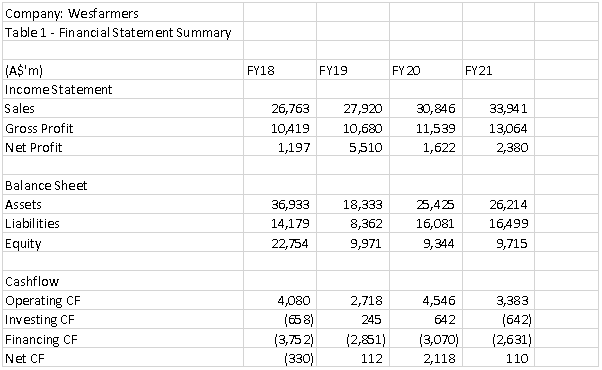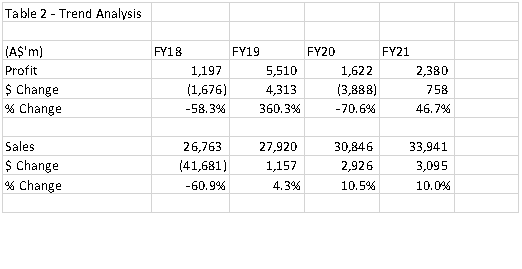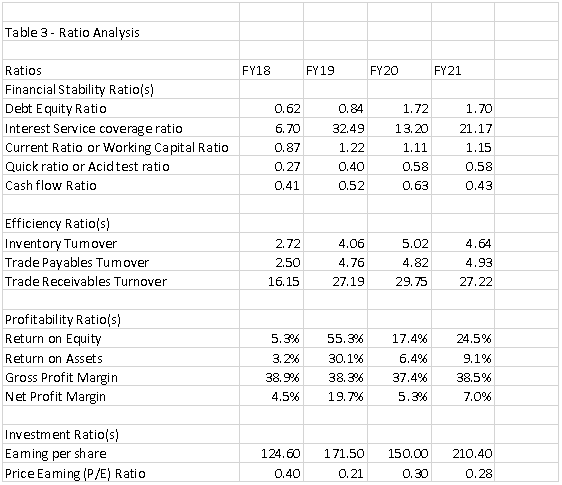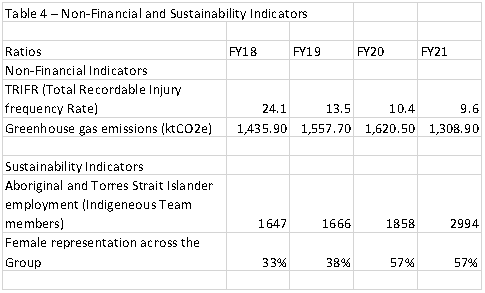Financial Analysis Assignment: Financial & Non-Financial Management of Wesfarmers
Question
Task: Students will select an ASX listed company and prepare a 2000-word report on financial analysis assignment regarding its financial and non-financial management.
Answer
Executive Summary
Background of a company to be examined in the financial analysis assignment -Wesfarmers is an Australian conglomerate company that is situated in Australia. The company has its operations in many sectors like retail, chemical, fertilizers, safety products etc. In the following assignment we will be providing a financial analysis of the overall company and take into consideration the data for 2019-2020 and 2020-2021. Non-financial factors are also taken into consideration that will help in drawing a conclusion on the overall financial position of the company. The company needs to carter to its stakeholders that consists of its shareholders, the customers, the public, government etc. An overall analysis of the financial statements of the company has been provided so that potential investors can decide whether they want to invest in the company or not and what are the necessary steps that they need to take to improve in the areas where the investors might feel insecure in investing the company(Johan, 2018). The company is listed on the Australian stock exchange and the overall prices of the shares fluctuates on the stock exchange based on the various conditions that the company is facing and that is affecting the share price adversely and in favor.
Relevant Stakeholder – The following assignment is presented to the relevant stakeholders that includes potential investors who are considering investing in the company.
Key Conclusion and Recommendations- The major recommendations includes whether the overall company position is financially feasible or not and whether the stakeholders should stick to the company and invest in the same. Financial analysis has been presented through calculation of important ratios that takes in consideration that liquidity, the profitability, and other factors of the company. A brief analysis of the same has been presented below.
Key Performance Indicators
Annual Return of the company with all the relevant data has been downloaded for 2 years 2019-2020 and 2020-2021.
1)The key performance highlights of the company have been provided below-
- The overall revenue of the company was $33.9b which is a 10% increase from the previous year.
- The net profit after tax has increased by 16.2% and that is around $2.4b.
- The shareholders have been given due returns for their overall investment with proposed capital return per share $2.00 and dividend per share is $1.78 per share.
- Apart from the financial key financial performance, it can also be seen that non-financial indicators like the greenhouse gas emissions have overall reduced by 9% which is around 1,476ktCO2 e and when it comes to social contributions it can be seen that the overall community contributions are around $55m. With respect to employees, it can be seen that the safety of the employees has been taken care of with reduction in total injury frequency rate has reduced to 9.6 rate and that is an important indicator(Johnson, 2017).
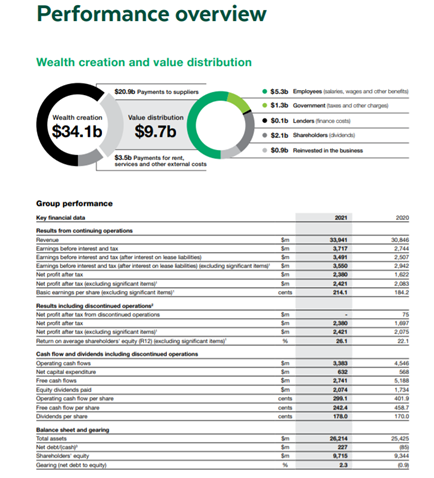
2)Relevant Financial Ratios
The key financial ratios with respect to profitability, liquidity and solvency has been calculated taken into consideration the data for past two years and comparison has been made to show how the company has grown over the years and analysis of the same has been provided in another section. Liquidity ratio takes into consideration the overall liquidity position of the company, whether the company is having enough liquid funds, profitability ratio takes into consideration the overall profitability aspect of the company, the amount of profit that they are making and investing(Venezia, 2017). The solvency ratio takes into consideration the overall solvency position of the company the amount of debt or equity that they are having. A brief calculation of the same has been presented-
Wesfarmers > Ratios Analysis
|
Wesfarmers > Ratios Analysis |
|||
|
|
|||
|
Name of the ratio |
Formulas |
2021 |
2020 |
|
Part A: Liquidity Ratios |
|||
|
Current Ratio or Working Capital Ratio |
Current Assets / Current Liabilities |
1.15 |
1.11 |
|
Quick ratio or Acid test ratio |
(Current Assets - Inventory) / Current Liabilities |
0.58 |
0.58 |
|
Cash flow Ratio |
Net cash flow from operating activities / Current Liabilities |
0.43 |
0.63 |
|
|
|
|
|
|
Part B: Profitability Ratios |
|||
|
Return on Equity |
Profit available to owners / Average Equity *100 |
24.50% |
17.36% |
|
Return on Assets |
Profit (loss) / Average total assets *100 |
9.08% |
6.38% |
|
Gross Profit Margin |
Gross Profit / Sales Revenue *100 |
38.49% |
37.41% |
|
Net Profit Margin |
Profit (loss) / Sales Revenue *100 |
7.01% |
5.26% |
|
Cash Flow to Sales |
Cash Flow from operating activities / Sales Revenue *100 |
9.97% |
14.74% |
|
|
|
|
|
|
Part C: Solvency (gearing) Ratios |
|||
|
Debt Equity Ratio |
Debt/Equity |
1.70 |
1.72 |
|
Debt to Asset Ratio |
Debt/Total Assets |
0.63 |
0.63 |
|
Interest Service coverage ratio |
EBIT/Interest cost |
21.17 |
13.20 |
|
|
|
|
|
|
Part D: Efficiency Ratios |
|||
|
Inventory Turnover |
COGS / Inventory |
4.64 |
5.02 |
|
Trade Payables Turnover |
COGS / Trade Payables |
4.93 |
4.82 |
|
Trade Receivables Turnover |
Sales / Trade Receivables |
27.22 |
29.75 |
|
|
|
|
|
|
Part E: Investment Ratios |
|||
|
Earning per share |
(Net income available to shareholders) / (Weighted average number of shares outstanding) |
210.40 |
150.00 |
|
Price Earning (P/E) Ratio |
Market Price per share / Earning per share |
0.28 |
0.30 |
|
|
|
|
|
Non-financial and Sustainability Indicators
The non-financial and sustainability factors take into consideration the corporate social responsibility of the company. The CSR statement that has been provided in the annual report of the company highlights the key performance of the company, it states how the company has functioned in the COVID-19 pandemic and has taken care of the shareholders and its team members in these hard times. The company has a nomination committee, a remuneration committee that takes key decision with respect to the company and thus fulfils the provision of the CSR policies(Webster, 2017). The company also has an audit report and an audit committee that highlights the key actions of the company and provides an independent audit opinion on the overall financials of the company. The investors can depend on the audit report and take a decision whether they want to invest in the company or not. It is important that investors should take into consideration the audit report before taking any decision with respect to the investment that they need to make. Non-financial indicators are highly important as they provide an insight into the management, the overall structure of the board and the company. Every listed company needs to get their books audited and that has been taken care of by the company(Yadao, 2018). It can also be seen that the company has taken care of the safety of its employees, has taken care of the greenhouse emissions, carbon emission and the same has been highlighted in the key performance indicator by the company. A screenshot of the same has been provided below-
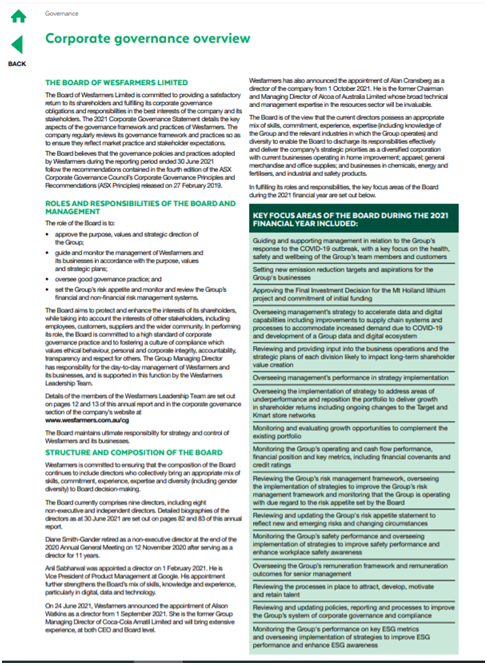
Interpretations and Insights
1. The main reasons for the changes in financials of the company are increase in sale and that has also been contributed due to increase in online sale due to the pandemic, the company has also taken steps that has helped in reduction of cost and the gross margin has increased because of that. It can also be seen that the company has made better investment with terms of CSR and employee safety and that has also helped in improving the overall financial position of the company.
2.In terms of the liquidity ratio, the current ratio has improved marginally from 1.11 times to 1.15 times whereas the quick ratio has remained constant as 0.58 times. These ratios show the ability of the company to pay off the short-term liabilities with the help of short-term assets. Liquid ratio shows the amount of liquid assets which the company has vs current liabilities. The ideal current and liquid ratio are considered to be 2 times and 1 time respectively and hence it can be said that the company does needs to improve in terms of liquidity even though it has improved slightly in 2021. On the other hand, cash flow ratio which shows operating cash flow vs current liabilities has declined significantly to 0.43 times from 0.63 times in 2020 is also a cause of concern as it shows less cash flow generated from operating business.
In terms of profitability, most of the ratios has improved in 2021 vs 2020, which is a positive sign for the company. One of the major drivers for increase in the gross profit ratio from 37.41% in 2020 to 38.49% in 2021 is the improvement in sales with a less than corresponding increase in COGS. This has helped in improving gross margins. Coupled with this, the reduced impairment expenses in 2021 has contributed to the net profit, which is why, it has improved from 5.26% to 7.01%. The return to equity as well as return on assets have improved significantly vs last year due to improvement in profitability and this a good sign for the investors. One of the major reasons for this improvement in topline and bottom line is the focus on online sales channel and the continued engagement within the teams. The cash flow to sales ratio has however declined due to reduction in operating cash flows driven by increase in payments to employees and suppliers vs last year(Yeates & Keoghan, 2019).
The solvency ratios indicate the capitals structure of the company and if the company has the ability to pay of interest costs with the earnings. Here in case of Wesfarmers, the debt equity ratio has marginally declined from 1.72 times in 2020 to 1.70 times in 2021 and similarly the debt to assets ratio has remained constant at 0.63 times. This shows that even though the company is leveraged but it has controlled the same and took adequate measures to maintain it. The interest services coverage ratio has however increased from 13.20 times to 21.17 times driven by increase in EBIT and marginally decline in interest expenses(Wesfarmers, 2020).
The efficiency ratios reflect the efficiency in the operations of the company and how best the resources are being used for generating sales and to maintain working capital. Here, the inventory turnover shows how quickly the inventory can be sold by company and the same has declined which is not positive. This is due to increase in inventory balances. On the other hand, trade payables ratio has declined, which is a positive indicator showing vendor payments on time. Lastly, the receivables turnover indicates how fast the collection is made from the customers once the sales has been made to the customers. The same has declined from 29.75 times to 27.55 times which again shows increase in debtor days and hence inefficiency in collection of receivables(Ylmaz & Altnkurt, 2012).
3. On the basis of CSR policies and the sustainability reports it can be seen that the company has done good number of investments in the required sector and because of that greenhouse gas emissions have overall reduced by 9% which is around 1,476ktCO2 e and when it comes to social contributions it can be seen that the overall community contributions are around $55m. With respect to employees, the safety of the employees has been taken care of with reduction in total injury frequency rate has reduced to 9.6 rate and that is an important indicator(Wild, 2013).
4. The major strengths of the Company that it is the biggest player in the private sector in Australia and New Zealand. It has an extensive network that will help in to tap the markets. It has a strong governing body, and it has a strong community building element. The major weakness includes factors like all the business interests are not equally profitable, it has a fully local supplier of power. The opportunities are with respect to growth in the online sector because of Covid, there are chances to diversify in other sectors also, but the company has faced threats with respect to severe competition with new entrants and new technologies being introduced.
Conclusion and Recommendation
Based on the overall analysis it can be said that the investors can invest in the company as the overall prospects of the company is very bright with increase in the overall sales and the profitability. The audit reports also shows that the books of the company have been properly checked and proper opinion on the same has been given. The company has been in operation since a long time and thus the investors can depend on the authenticity of the same and accordingly invest.
References
Johan, S., 2018. The Relationship Between Economic Value Added, Market Value Added And Return On Cost Of Capital In Measuring Corporate Performance. Jurnal Manajemen Bisnis dan Kewirausahaan, 3(1), pp. 121-134.
Johnson, R., 2017. The Best Strategies for Investing. In the News, pp. 21-31.
Venezia, I., 2017. Behavioral Finance: 'Where Do Investors'' Biases Come From'. Singapore: WORLD SCIENTIFIC.
Webster, T., 2017. Successful Ethical Decision-Making Practices from the Professional Accountants' Perspective.
ProQuest Dissertations Publishing, 3(1), pp. 142-156.
Wesfarmers, 2020. Annual Report, Perth: Wesfarmers Limited.
Wild, S., 2013. Accounting for Heritage, Cultural and Community Assets – Alternative Metrics from a New Zealand Mori Educational Institution.Financial analysis assignmentAustralasian Accounting, Business and Finance Journal, 7(1), pp. 3-22.
Yadao, J., 2018. Forensic accountants and big data.
Yeates, C. & Keoghan, S., 2019. Big banks and accounting firms defend auditors' independence. Banking and Finance, 3 August, pp. 2-8.
Ylmaz, K. & Altnkurt, Y., 2012. An examination of articles published on preschool education in Turkey. Educational Sciences: Theory & Practice , pp. 3227-3241.
Appendix
